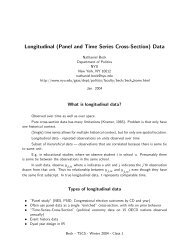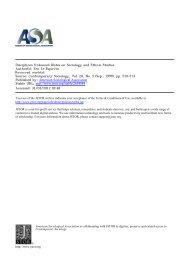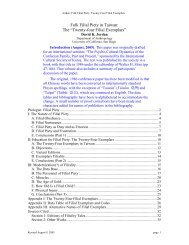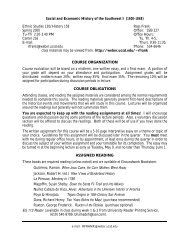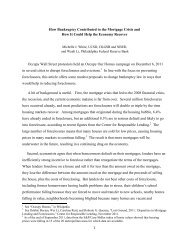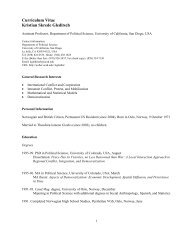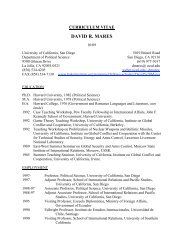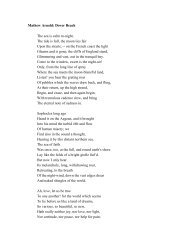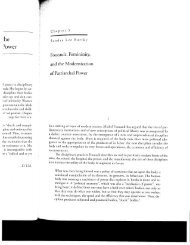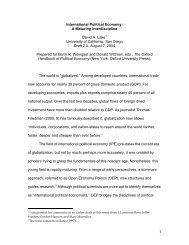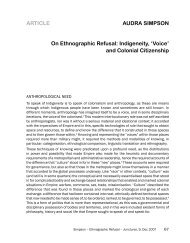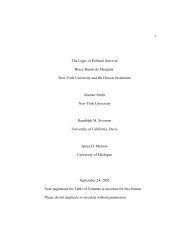Climate change and water resources in the Murray Darling Basin ...
Climate change and water resources in the Murray Darling Basin ...
Climate change and water resources in the Murray Darling Basin ...
You also want an ePaper? Increase the reach of your titles
YUMPU automatically turns print PDFs into web optimized ePapers that Google loves.
ABARE CONFERENCE PAPER 02.11<br />
costs to agriculture of almost $1.2 billion <strong>in</strong> net present value terms. This falls to about<br />
$0.8 billion under <strong>the</strong> SRES B1 scenario. As it was assumed that dryl<strong>and</strong> agricultural<br />
yields are unaffected by <strong>the</strong> comb<strong>in</strong>ation of decl<strong>in</strong><strong>in</strong>g precipitation <strong>and</strong> <strong>in</strong>creased atmospheric<br />
concentrations of carbon dioxide, <strong>the</strong>se decl<strong>in</strong>es are pr<strong>in</strong>cipally caused by <strong>the</strong> reduction<br />
<strong>in</strong> surface <strong>water</strong> flows <strong>and</strong> consequent reduction <strong>in</strong> irrigated agricultural production.<br />
Increased river sal<strong>in</strong>ity also reduces irrigation yields <strong>and</strong> imposes additional costs on urban<br />
<strong>and</strong> <strong>in</strong>dustrial users below Morgan but <strong>the</strong> order of magnitude of <strong>the</strong>se impacts is considerably<br />
lower.<br />
There are substantial reductions <strong>in</strong> flow under both scenarios. In <strong>the</strong> SRES A1 scenario,<br />
flow reductions range across <strong>the</strong> catchments from 16 to 25 per cent <strong>in</strong> 2050 <strong>and</strong> between<br />
24 <strong>and</strong> 48 per cent by 2100. The reductions <strong>in</strong> precipitation <strong>and</strong> <strong>in</strong>creases <strong>in</strong> potential evaporation<br />
are lower <strong>in</strong> <strong>the</strong> SRES B1 scenario generat<strong>in</strong>g smaller reductions <strong>in</strong> stream flows.<br />
The difference <strong>in</strong> flows between <strong>the</strong> scenarios escalates over time. Flows are between 4<br />
Table 1: Changes <strong>in</strong> economic returns for <strong>the</strong> SRES climate scenarios, compared with <strong>the</strong><br />
reference case<br />
SRES A1 SRES B1 Difference between<br />
Region No trade No trade scenarios<br />
$m, npv $m, npv %<br />
Nor<strong>the</strong>rn catchments –480 –326 32<br />
Sou<strong>the</strong>rn catchments –442 –287 35<br />
Victorian Mallee <strong>and</strong> South Australian Riverl<strong>and</strong> –256 –177 31<br />
Adelaide –50 –36 28<br />
Total –1 228 –826 33<br />
Table 2: Flows <strong>and</strong> salt concentrations at selected locations<br />
Reference scenario Change to 2050 Change to 2100<br />
Location 2000 2050 2100 A1 B1 A1 B1<br />
Flows GL GL GL % % % %<br />
Goulburn–Broken River 2 397 2 475 2 481 –19 –15 –35 –23<br />
Gwydir River 587 619 679 –25 –19 –48 –30<br />
Murrumbidgee River a 7 453 7 691 7 863 –14 –10 –24 –16<br />
Darl<strong>in</strong>g River a 8 237 8 583 8 851 –16 –12 –29 –20<br />
Morgan 6 898 7 210 7 451 –16 –12 –29 –20<br />
Sal<strong>in</strong>ity Mg/L Mg/L Mg/L % % % %<br />
Goulburn–Broken River 52 60 62 15 13 40 21<br />
Gwydir River 123 145 182 19 16 72 35<br />
Murrumbidgee River a 138 153 177 –8 –6 –25 –16<br />
Darl<strong>in</strong>g River a 222 269 302 2 1 –12 –8<br />
Morgan 307 397 454 4 2 –10 –6<br />
a At <strong>the</strong> confluence of <strong>the</strong> <strong>Murray</strong> River.<br />
23




